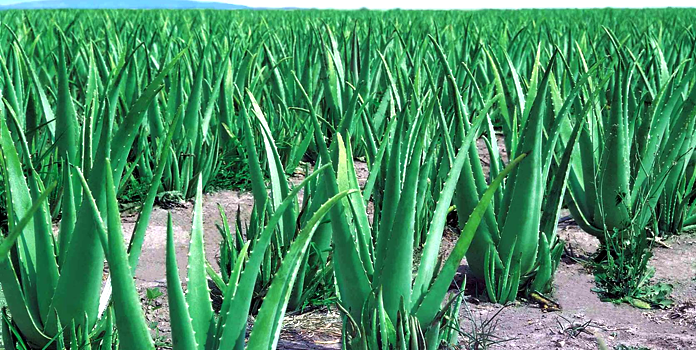Herbs A-B
Herbs C-D
Herbs E-M
Botanical Name : Aloe barbadensis
Other Names : Curacao Aloe, Barbados Aloe, Aloe Indica, Ghrita-kumari
Introduction :
The virtues of Aloe Vera have been recorded for thousands of years by many ancient civilizations, including Egypt, Persia, Greece, India and Africa. The name was derived from the Arabic alloen meaning 'bitter' because of the bitter liquid found in the leaves. In 1500 B.C. Egyptians recorded use of the herbal plant in treating: burns, infections & parasites. It is reported that Aloe was used to embalm the body of Christ. Spanish missionaries in the west always planted Aloe around their settlements and carried it on their journeys to aid the sick.
Origin :
Aloe, native to East and South Africa, is also known as 'lily of the desert', the 'plant of immortality', and the 'medicine plant'. Aloe barbadensis was introduced to the West Indies at the beginning of the 16th century.

Chemical composition/key active constituents
Aloe Vera leaf contains major Glycosides - Anthracene derivatives: Hydroxyanthraquinone derivatives (25-40) viz., aloin (=barbaloin, a mixture of aloin A & B, the disstereoisomeric 10-C glucosides of aloe-emodin anthraone) and 7-hydroxyaloin isomers. Minor contain includes aloe emodin, chrysophanol, Chromone derivative viz., aloeresin B (=aloesin, upto 30%) with its p-coumaryl derivatives aloeresins A & C and the aglycone aloesone. The active principle of aloe is a mixture of glycosides called aloin. The proportion of aloin varies in different specimens of aloes. The chief constituent of aloin is barbaloin which is a pale yellow crystalline glycosides, soluble in water.
Remedies For Bacterial, Viral, Fungal and Parasitic Conditions
- Eliminates parasites (especially protozoan infections)
- Relieves Herpes simplex & zoster
- Relieves symptoms of Candida
- Relieves symptoms of Epstein-Barr virus (chronic fatigue syndrome)
- Relieves symptoms of fungal infections
- Relieves symptoms of genital herpes
- Relieves symptoms of yeast infections
- Staphylococcus infections
- Vaginitis
- Viral infections
Blood Conditions
- Aids hyperglycemia
- Aids in blood circulation
- Hemorrhoids
- Lowers blood sugar in people with type 2 (non-insulin-dependent) diabetes
Cardiovascular Conditions
- Relieves hypertension
Female Conditions
- Menstrual cramps and irregularity
- Suppressed menses
Gastrointestinal Conditions
- Acts mainly on the large intestine
- Colic
- Constipation
- Dyspepsia
- Facilitates digestion by aiding the immune system
- Helps cleanse the digestive tract by exerting a soothing, balancing effect
- Helpful the stomach, small intestine and colon
- Intestinal infection
- Keeps the bowels functioning smoothly and helps when there is an impaction
- Moves allergenic proteins from the small intestine into the colon
- Aids in healing wounds by drawing out infection and preventing infection from starting
- Naturally alkalizes digestive juices to prevent over-acidity
- Promotes a favorable balance of gastrointestinal symbiotic bacteria and decreased yeast populations
- Relieves nausea
- Relieves symptoms of indigestion
- Stimulates intestinal motility
Aloe is used for inflammatory bowel conditions such as:
- Crohn's disease
- Gastritis
- Irritable bowel syndrome
- Ulcerative colitis
Genitourinary Conditions
- assists kidney function
Immune System Conditions
- Allergic reactions
- Has immune-stimulating actions
- Strengthens the body's natural resistance
Inflammatory Conditions
- Relieves arthritis
Liver Conditions
- Assists liver and gall bladder functions
- Helps hypercholesterolemia
Respiratory Tract Conditions
- Colds
- Relieves symptoms of esophagal reflex
- Relieves symptoms of gingivitis
Pharmacology :
Cathartic action of the drug, limited to large intestine, is attributed to anthraquinone glycosides, chiefly aloin. Latter is not absorbed in upper gut but hydrolysed to the active aglycone at the site of action in the colon and rectum by intestinal bacteria. The anthraones irritate the mucus membrane, leading to an increase in the secretion of mucus, thus stimulating peristalsis. Also they induce an active secretion of water and electrolytes into the lumen of the gut and inhibit the absorption of electrolytes and water by the colon.
Statements on this website is collected from online and offline references, they are an effective way of learning and sharing. With this knowledge, we can take control of our own health. These statements have not been evaluated by the FDA. Products and techniques mentioned here are not intended to diagnose, treat, cure or prevent any disease. However, when you give the body what it needs then the body can heal itself as God intended it to. We are bulk suppliers/Exporters of herbs, and raw materials this website is intend to provide option for various herbs buyers/importers/our customers, buy small Qty swiftly and pay for the product and shipping.